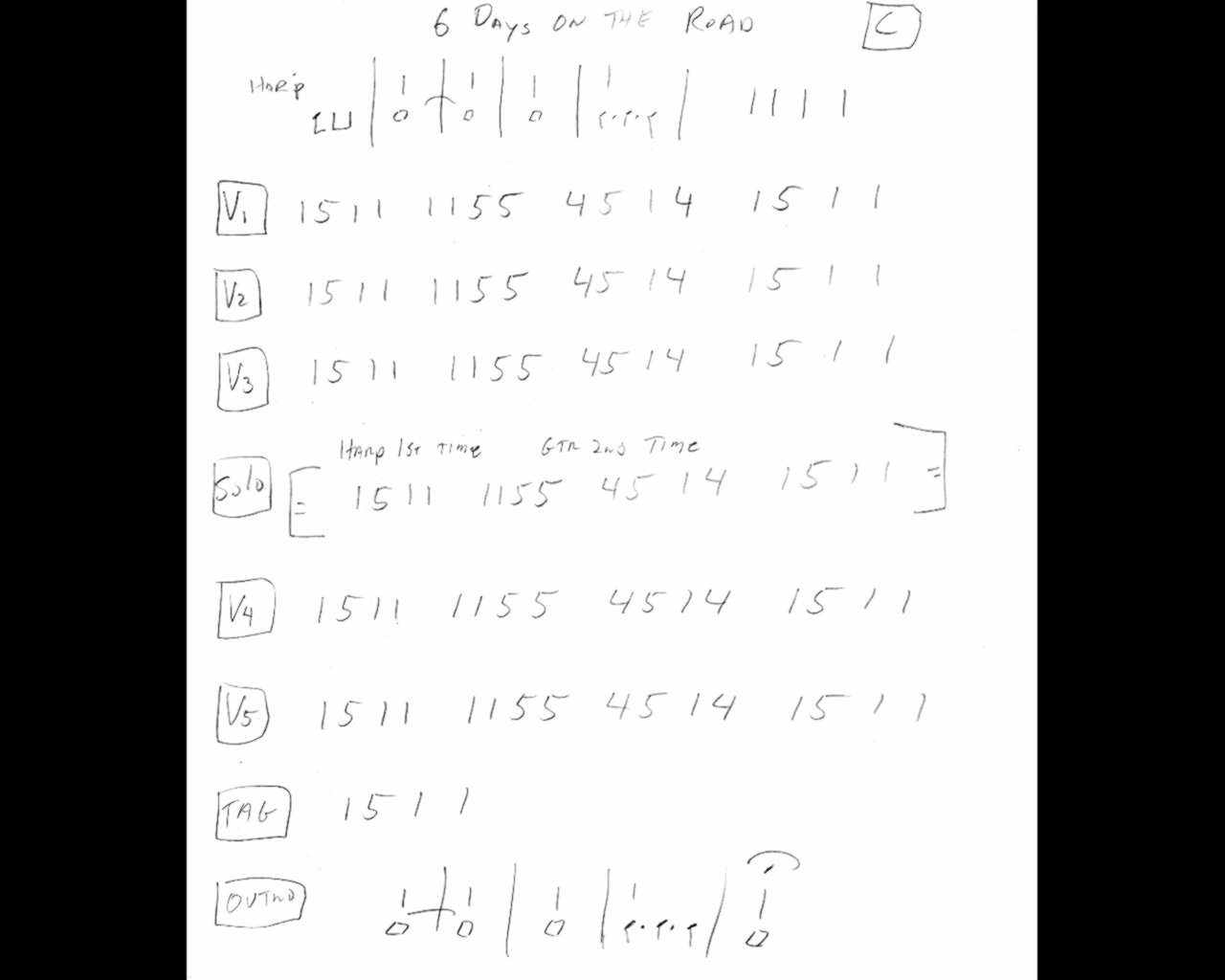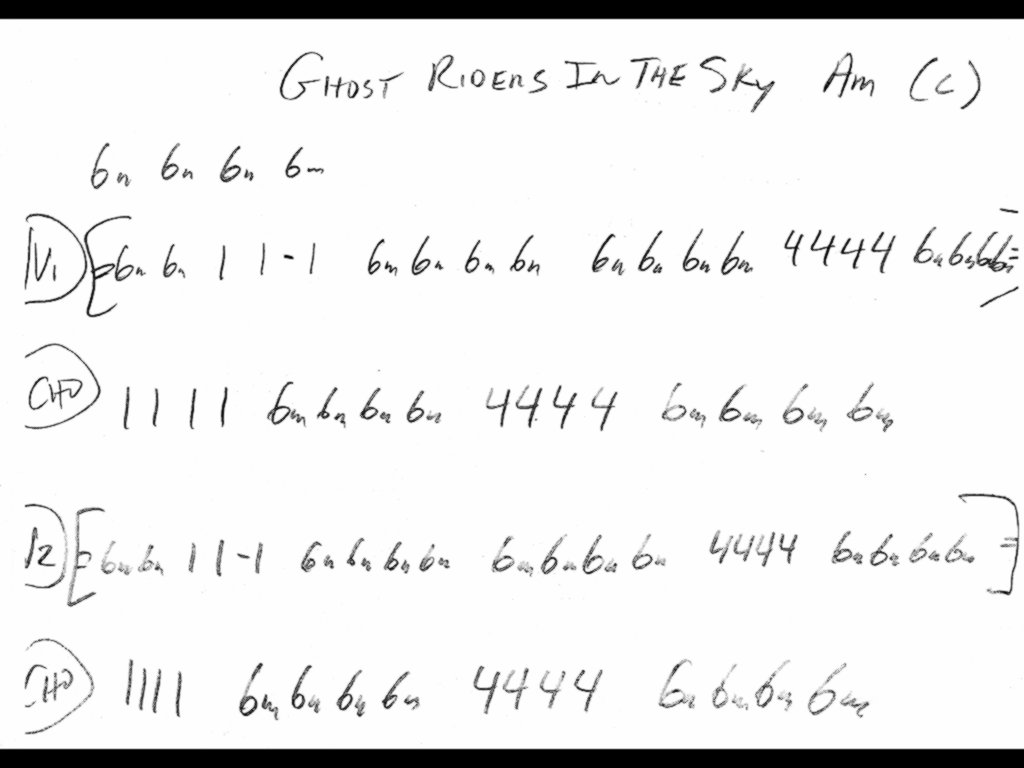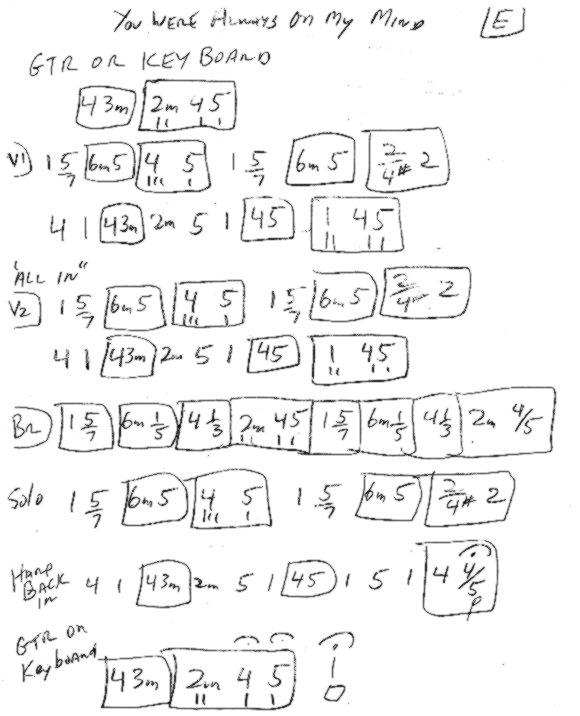Page 2 of 3
Posted: 22 Sep 2011 7:53 pm
by Butch Gardner
Chas Williams in his book The Nashville Number System states on page 12 "However, in Nashville, most of the time, for a song in a minor key, the chord chart will be written as if in the relative major key". I think the point of the original question goes to what method is universally used. A good thread, and I have learned something today. That is a good thing.
Butch
Posted: 22 Sep 2011 11:08 pm
by Clete Ritta
Brint Hannay wrote:...Number charts using Roman numerals...are a different beast from Nashville number charts...
Brint, thanks for pointing that out! I obviously dont use the number system.

I didnt know that the NNS uses only flats in front of the number. Are sharps used after for altered chords like Ab7#9?
I used Roman numerals in my earlier post, and didnt realize till now. I would have written the chords Am G Dm as: 6m 5 2m in the key of C major, just as Christopher was inclined. I would write the chords Am G D as 2m 1 5 in the key of G major, just to clarify that I try to base a minor key by its relative major key, which does seem to be the norm.

Clete
Posted: 23 Sep 2011 4:08 am
by John Lacey
I suppose it depends on what you're comfortable with. I find when I write charts if confronted by a tune with predominately minor chords I tend to go back to letter names instead of numbers. Just less confusing.
Posted: 23 Sep 2011 6:51 am
by Larry Bell
There are as many variations of the Nashville Numbers System as there are musicians who use it. Simple as that. There are many similarities but everyone has his/her own twist on it.
I learned a lot from working a few shows with Charlie McCoy. When you are the bandleader on Hee Haw for almost 20 years you have a lot of 'street cred' and his charts were used by sidemen like Leon Rhodes and Curly Chalker.
Charlie writes measures in groups of 4, with as many as 16 bars on one line and augments that with codas, repeats, and timing written out in std music notation. That's what works best for me, FWIW. You get an entire arrangement on one page and can read through the changes just like sheet music.
As for the 'minor confusion', I'm in the 'relative major' camp, except for a tune like 'The Thrill is Gone', which I would consider a minor blues and would write the tonic as 1m. When players use their own charts they are free to write it out however works best for them. The bottom line is that charts help us play more songs in a limited time than we can really learn thoroughly by repetition. I've had many weeks when freelancing that I've had to play 20 or more songs that I'm not that familiar with only a few days to prepare. For me, the number charts are a godsend.
Another plus is that, after writing it out and using it a time or two, I usually don't need the chart any more and can file it away. Your mileage may vary.
Here's an example of one of Charlie's charts.

There's A LOT OF INFORMATION on this page. A musician who is experienced reading charts could play this song for the first time without missing a beat.
Posted: 23 Sep 2011 7:48 am
by Brint Hannay
Clete Ritta wrote:Brint Hannay wrote:...Number charts using Roman numerals...are a different beast from Nashville number charts...
Brint, thanks for pointing that out! I obviously dont use the number system.

I didnt know that the NNS uses only flats in front of the number. Are sharps used after for altered chords like Ab7#9?
I didn't say only flats are used.
I used flats in my scale numbers list, but that's me. I've never been to Nashville, but I'm sure sharps are used as well. For me, whether I use, say, b5 or #4 depends on my feeling of the context.
Posted: 23 Sep 2011 10:39 am
by Clyde Mattocks
Thanks for this thread and thanks to Paul for his input. This comes at a very opportune time as I am charting tunes for a project I am doing on upright bass. Many of the songs are in minor keys with lots of odd changes. Writing the charts in the relative major always seemd easier for me. It's good to see that is the predominately accepted way.
Posted: 23 Sep 2011 10:59 am
by Skip Edwards
Not really about minors, but...
All this info about charts is great, but it's only a part of the beauty of using numbers.
The real benefit of using numbers, rather than chord letters, is the ability to train your ears to hear the changes - developing an good sense of relative pitch.
Ex...On first hearing, the majority of folks can't really differentiate, say, a C to F change from an E to A, or a G to C, but they can hear the 1 to the 4, and so on.
I think being able to hear and recognize the numbers is an essential part of your ability to be proficient on your instrument. It gives you the ability to follow a tune without having heard it before or scratch out a chart on first hearing, etc.
Hearing the numbers just opens your ears up more to the music you're playing.
Posted: 23 Sep 2011 11:59 am
by CrowBear Schmitt
you've brought up a very good point Skip
using numbers makes playing in any key easy
Larry B could i abuse of your time & attention ?
since the 6 days on the road chart is pretty simple & repetitive, would you have a more consequent chart using NNS w: major7, diminished, minor 9, augmented & 11 or sus 4 & other altered or demented chords ?
why you can even modulate too
Thanx a bunch

Posted: 23 Sep 2011 1:08 pm
by Larry Bell
Sure, C-B
Here is one in a minor key (Ghost Riders) written in the relative major as we've discussed

Crazy has dim and aug chords
(sorry about the dark blotches -- I made notations in pink highlighter and they show through)
Also, RE: Writing out specific chords / vs subs
Charlie seems to rely on the musician's intuition to know, e.g., to use a C6 for the 1 chord or to use a Dom9 or Dom7 to lead to a 4 chord, whether it's written or not. A 2m could be a 2m9 or 2m7 depending on the context. HOWEVER, if it's germane to the song, he will specify.
There's also a 'slash chord' on Line 2 of V1 -- a 1 chord with a 3 in the bass (written 1/3)
-- and also split measures -- what's inside the rectangle is a single measure. If there are two chords they are assumed to each have two beats, otherwise there are hash marks under the symbol to show how many beats to play that chord).

I know we modulated on a tune or two but don't see an example in my folder. 'Mod to 2' was what I recall for modulating up from C to D or E to F#. To go back it would be 'Mod to b7'. I've also seen 'Mod +2' and 'Mod -2' to go back.
I've learned a lot from Charlie -- can't think of many musicians I respect as much -- right up there with the Big E in my book.

Posted: 23 Sep 2011 2:03 pm
by Joey Ace
Larry,
Thanks so much for sharing the CM charts.
There's no doubt he's 'the man'.
One thing I find odd is that in the "Six Days" chart he's taken the time, and page space, to document every line, while all but the Intro and Outro are the same.
That's not how I would do it.
I'd indicate:
V2: s/a V1
V3: s/a V1
etc.
Is there an advantage to writing out every line, vs shorthand?
FWIW, I'm also in the "Relative Minor Camp".
I could easily chart "House of the Rising Sun" with numbers beginning with 6m.
However if I had to do "Sultans of Swing" I'd name the chords and skip the numbers.
I once wrote out that song with numbers, just to prove I could do it. It was not an easy task, and when finished I couldn't follow my own number chart.
Posted: 23 Sep 2011 2:22 pm
by Larry Bell
Hey Joey
The way he explained it to me was he wanted the player to follow the chart straight through, using repeats and codas where appropriate, but he avoids stuff like 'V2 -- same as V1' because your eyes have to go back and forth on the page. I like having every chord written out and, when you can write a 16M verse on one line, you have the real estate on the page to do that.
All a matter of personal preference. Like I said b4, there are as many implementations of NNS as there are musicians who write charts.
Posted: 23 Sep 2011 6:18 pm
by Jim Cohen
Larry Bell wrote: Like I said b4, there are as many implementations of NNS as there are musicians who write charts.
I followed you pretty well, Larry, until you got to that flat-4...

Posted: 23 Sep 2011 6:22 pm
by Bo Legg
If you've ever had to play to charts in a minor key and they were written other than using the relative minor you know what a nightmare that is.
When someone hands me a chart that is all scribbled up, smudged with hard to read handwriting I feel like wiping my butt with it.
It's like saying here dummy if you have to have a chart don't expect me to spend any time on it.
Don't disrespect a musician with a half Aas attempt at a chart.
Posted: 23 Sep 2011 6:55 pm
by Larry Bell
Jimbeaux wrote:I followed you pretty well, Larry, until you got to that flat-4...
You know, it's 3 of one . . . flat-4 of the other

Posted: 23 Sep 2011 11:20 pm
by Clete Ritta
I was in Nashville only once. It was a sunny afternoon in 1999, and I was just looking at hats and belts. I never saw any live music, unfortunately, but I was on my way from Florida to Kentucky, where I played a mandolin for the very first time on a front porch, just like I pictured it.

Larry Bell wrote:...There's also a 'slash chord' on Line 2 of V1 -- a 1 chord with a 3 in the bass (written 1/3)...
Though not in NNS, I often will notate chords in this manner, that is, by simplifying a complex chord by using a typical chord with a slash and different root note. There is a lot of common ground in this thread, and the variety of ways the NNS is used is really interesting to me. Its like stenographers shorthand for music notation. Please post more charts!
Clete
Posted: 24 Sep 2011 1:20 am
by CrowBear Schmitt
Thanx Larry

this has been an enriching thread - you learn sumpthin'ev'ry day

yes Larry, give us a real hard chart now !
as i wrote, i'm used to the Roman NS, & the NNS is imo quite similar - gettin' used to it should'nt be really difficult
in some cases,i rewrite a chart in respect to the key & the chords that go w: it & not use the numbers system
as i'm sure you know Larry, Charlie comes to France most every year & he plays w: his usual all European band " the United "
Jean Yves Lozach's been w: him/them since day 1
my buddy "Yoyo" has stood in fer Jean Yves quite a few times as well
We all love Charlie here & heck, he loves us too !
Posted: 24 Sep 2011 5:37 am
by Franklin
.......I mostly see a line underneath the numbers to indicate a split bar........ This is pretty much standard - the bass notes are found below the initial chord number written as a fraction and the musical notes for rhythmic style are written above the chord.....The NNS has evolved due to the requirement of additional information needed to make the song easily learned.
Paul
Posted: 24 Sep 2011 5:42 am
by Larry Bell
Yeah, C-B, Charlie speaks fondly of the group in Europa. The first show I did with him included several 'barn burners' -- really fast tempos on tunes like 'John Henry', 'Rollin in My Sweet Babys Arms', 'Sugarfoot Rag'. He included a CD with the European band, with Jean Yves, just kickin' butt. The tempos pushed my meager technique to the limit. When he walked in I mentioned that I could just barely pull off the solos at that tempo, and his response cracked me up:
"I don't usually play those tunes THAT fast but the guys in the band decided they were going to play a prank on me and see if I could keep up. Those Frenchmen have a unique, sadistic sense of humor."

I'm playing a few shows with him in Florida this December. He and his wife (who, if I recall correctly, is French) have a place near where I live on the Gulf coast of Florida. I ALWAYS look forward to working with a legend like Charlie McCoy.
As far as a more complicated chart, the point is to simplify the song as much as possible and make it easy for a musician who may not have even heard the tune to be able to play it the first time. Avoiding complexity while conveying as much detail as possible of the song is the objective. As Paul points out, some chart writers underline a split bar and I've seen a few (me included) who put split bars in parentheses or brackets.
Here is one more -- a bit more complex -- for your amusement.


Posted: 24 Sep 2011 7:44 am
by Brian McGaughey
Larry, so anytime a bar has more than one chord, it's got a square drawn around it? That's an easy way to catch every change when you don't know the tune's direction. Cool!
I see CM put slash marks under the chords if it's not an even split of the bar.
Posted: 24 Sep 2011 7:57 am
by Paul Arntson
This is a GREAT thread!!
Thank you so much for this!
Much appreciated.
Posted: 24 Sep 2011 8:08 am
by Larry Bell
Correct, Brian.
Each individual letter denotes a full measure, measures with more than one chord are in a rectangle (or underlined or parentheses or brackets) with the slashes designating how many beats, and any timing can be written out in std notation if necessary.
It is noteworthy that number charts for jazz tunes can get really out there when tone centers change. The coin of the realm for jazz tunes, in general, is the fakebook, with chord names. A competent musician can read either (IMHO).
Posted: 24 Sep 2011 8:23 am
by Jerry Overstreet
I'd recommend the spiral bound book Butch referenced: The Nashville Number System by Chas Williams for anyone wanting to understand and get started using the NNS. There are several charts from Charlie, Jimmy Capps et al. plus the study of time sigs., tempo, some theory and other musical convention and explanation.
Posted: 24 Sep 2011 9:05 am
by Larry Bell
That's a great recommendation, Jerry. I've seen the book but don't own it -- as I recall it lays the system out very well with a bunch of examples.
The ability to read music is a plus since the concept of 1st and 2nd endings, repeats, codas, time signatures, note values, scale and chord composition, etc. are used as part of the system. If you don't have that background knowledge you may find the need to learn the BASICS of reading std notation.
I find these skills most important when I play with multiple groups, especially in pick-up band situations and fill-in work. If I have a chart I'm good to go and I've gotten to the point where I can usually write one out in two passes and can usually do it without my guitar. Reading and writing charts is a valuable skill to have in your arsenal, IMHO.
Posted: 24 Sep 2011 9:13 am
by Chris Tweed
+1 for the book.
It's more than a book. It comes with a CD and each track is explained and charted in the book. An excellent learning resource even if you don't plan to use the NNS often.
Posted: 24 Sep 2011 12:27 pm
by Christopher Wray
Good gosh! I just opened up my computer and decided to check the thread to see if anyone else had commented and was blown away! Thank you all so much for contributing. There is no other thread online that contains this much information and contribution on this subject. Believe me, I checked before starting the thread. This just made my day. Thanks again!
-Christopher



